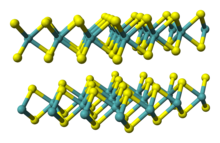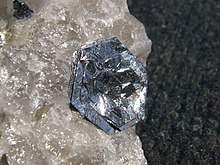Molybdenum disulfide

| |

| |
| Names | |
|---|---|
| IUPAC name
Molybdenum disulfide
| |
| Other names | |
| Identifiers | |
3D model (JSmol)
|
|
| ChEBI | |
| ChemSpider | |
| ECHA InfoCard | 100.013.877 |
PubChem CID
|
|
| RTECS number |
|
CompTox Dashboard (EPA)
|
|
| |
| |
| Properties | |
| MoS2 | |
| Molar mass | 160.07 g/mol |
| Appearance | black/lead-gray solid |
| Density | 5.06 g/cm3 |
| Melting point | 1185 °C decomp. |
| insoluble | |
| Solubility | decomposed by aqua regia, hot sulfuric acid, nitric acid insoluble in dilute acids |
| Structure | |
| Hexagonal, hP6, space group P63/mmc, No 194 | |
| Trigonal prismatic (MoIV) Pyramidal (S2−) | |
| Related compounds | |
Other anions
|
Molybdenum(IV) oxide |
Other cations
|
Tungsten disulfide |
Except where otherwise noted, data are given for materials in their standard state (at 25 °C [77 °F], 100 kPa).
| |
Molybdenum disulfide is the inorganic compound with the formula MoS
2. The compound is a di-chalcogenide.
This black crystalline sulfide of molybdenum occurs as the mineral molybdenite. It is the principal ore from which molybdenum metal is extracted. MoS2 is relatively unreactive, being unaffected by dilute acids and oxygen. In its appearance and feel, molybdenum disulfide is similar to graphite. Indeed, like graphite, it is widely used as a solid lubricant because of its low friction properties and robustness.
Production

Molybdenite ore is processed by flotation to give relatively pure MoS2, the main contaminant being carbon. MoS2 also arises by the thermal treatment of virtually all molybdenum compounds with hydrogen sulfide. The natural amorphous form is known as the rarer mineral jordisite.
Molybdenite (MoS2) is the principal ore from which molybdenum metal is extracted.[1]
Structure and physical properties
In MoS2, each Mo(IV) center occupies a trigonal prismatic coordination sphere, being bound to six sulfide ligands. Each sulfur centre is pyramidal, being connected to three Mo centres. In this way, the trigonal prisms are interconnected to give a layered structure, wherein molybdenum atoms are sandwiched between layers of sulfur atoms.[2] Because of the weak van der Waals interactions between the sheets of sulfide atoms, MoS2 has a low coefficient of friction, resulting in its lubricating properties. Other layered inorganic materials exhibit lubricating properties (collectively known as solid lubricants (or dry lubricants)) including graphite, which requires volatile additives, and hexagonal boron nitride.[3]
Bulk MoS2 is diamagnetic, indirect bandgap semiconductor similar to silicon, with a gap of 1.2 eV. Because of its anisotropic structure, it exhibits anisotropic conductivity. It has been often investigated as a component of photoelectrochemical (e.g. for photocatalytic hydrogen production) applications and more recently for microelectronics applications.[4] Single layers have proven to have properties differing from the bulk, including a direct 1.8 eV electronic bandgap.[5]
Chemical reactions
Molybdenum disulfide is stable in air, consistent with its existence as a common mineral. It does react with oxygen upon heating forming molybdenum trioxide:
- 2 MoS2 + 9 O2 → 2 MoO3 + 4 SO3
Chlorine attacks molybdenum disulfide at elevated temperatures to form molybdenum pentachloride:
- 2 MoS2 + 7 Cl2 → 2 MoCl5 + 2 S2Cl2
Molybdenum disulfide reacts with alkyl lithium under controlled conditions to form intercalation compounds LixMoS2.[6] With butyl lithium, the product is LiMoS2.[1]
Applications
Lubricant
MoS2 with particle sizes in the range of 1–100 µm is a common dry lubricant. Few alternatives exist that can confer the high lubricity and stability up to 350 °C in oxidizing environments. Sliding friction tests of MoS2 using a pin on disc tester at low loads (0.1–2 N) give friction coefficient values of <0.1.[7][8]
Molybdenum disulfide is often a component of blends and composites where low friction is sought. A variety of oils and greases are used, because they retain their lubricity even in cases of almost complete oil loss, thus finding a use in critical applications such as aircraft engines. When added to plastics, MoS2 forms a composite with improved strength as well as reduced friction. Polymers that have been filled with MoS2 include nylon (with the trade name Nylatron), Teflon, and Vespel. Self-lubricating composite coatings for high-temperature applications have been developed consisting of molybdenum disulfide and titanium nitride by chemical vapor deposition.
Examples of some diverse applications of MoS2-based lubricants include two-stroke engines (e.g., motorcycle engines), bicycle coaster brakes,automotive CV and universal joints, ski waxes,[9] and even some bullets.[10]
Petroleum refining
MoS2 is employed as a catalyst for desulfurization in petroleum refineries; e.g., hydrodesulfurization.[11] The effectiveness of the MoS2 catalysts is enhanced by doping with small amounts of cobalt or nickel and the intimate mixture is supported on alumina. Such catalysts are generated in situ by treating molybdate/cobalt or nickel-impregnated alumina with H2S or an equivalent reagent.
Electronics
Sheets of MoS
2 can be produced using chemical vapor deposition. Unlike graphene, MoS
2 has a bandgap, essential for making transistors. A switchable transistor based on single- and multi-layer MoS2 have been described.[4]
Research trends
Nanotubes and buckyball-like molecules composed of MoS2 exhibit unusual tribology and electronic properties.[12] Metal di-chalogenides form two-dimensional nanocrystals” layered in sheets of a thickness of 0.7 nanometers or roughly the width of three or four atoms.[13]
References
- ^ a b Roger F. Sebenik et al. "Molybdenum and Molybdenum Compounds" in Ullmann's Encyclopedia of Chemical Technology 2005; Wiley-VCH, Weinheim. doi:10.1002/14356007.a16_655
- ^ Wells, A.F. (1984). Structural Inorganic Chemistry. Oxford: Clarendon Press. ISBN 0-19-855370-6.
- ^ Thorsten Bartels; et al. (2002). "Lubricants and Lubrication". Ullmann's Encyclopedia of Industrial Chemistry. Weinheim: Wiley VCH. doi:10.1002/14356007.a15_423.
{{cite book}}: Explicit use of et al. in:|author=(help) - ^ a b Radisavljevic, B.; Radenovic, A.; Brivio, J.; Giacometti, V.; Kis, A. (2011). "Single-layer MoS2 transistors". Nature Nanotechnology. 6 (3): 147–150. doi:10.1038/nnano.2010.279.
- ^ Splendiani, A.; Sun, L.; Zhang, Y.; Li, T.; Kim, J.; Chim, J.; F. (2010). "Emerging Photoluminescence in Monolayer MoS2". Nano Letters. 10 (4): 1271–1275. doi:10.1021/nl903868w.
- ^ W. Müller-Warmuth, R. Schöllhorn (1994). Progress in intercalation research. Springer. p. 50. ISBN 0-7923-2357-2.
- ^ G. L. Miessler and D. A. Tarr (2004). Inorganic Chemistry, 3rd Ed. Pearson/Prentice Hall publisher. ISBN 0-13-035471-6.
- ^ Shriver, D. F.; Atkins, P. W.; Overton, T. L.; Rourke, J. P.; Weller, M. T.; Armstrong, F. A. (2006). Inorganic Chemistry. New York: W. H. Freeman. ISBN 0-7167-4878-9.
{{cite book}}: CS1 maint: multiple names: authors list (link) - ^ "On dry lubricants in ski waxes" (PDF). Swix Sport AX. Retrieved 2011-01-06.
- ^ "Barrels retain accuracy longer with Diamond Line". Norma. Retrieved 2009-06-06.
- ^ Topsøe, H.; Clausen, B. S.; Massoth, F. E. (1996). Hydrotreating Catalysis, Science and Technology. Berlin: Springer-Verlag.
{{cite book}}: CS1 maint: multiple names: authors list (link) - ^ Y. Feldman, E. Wasserman, D.J. Srolovitz, and R. Tenne "High-Rate, Gas-Phase Growth of MoS2 Nested Inorganic Fullerenes and Nanotubes" Science 267, 222-225 (1995).
- ^ "Layered '2D nanocrystals' could replace CMOS transistors". KurzweilAI. doi:10.1002/pssr.201307015. Retrieved 2013-04-19.
